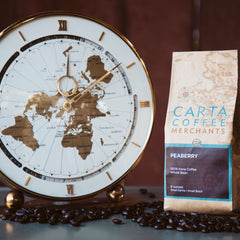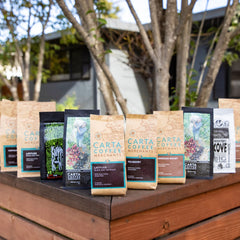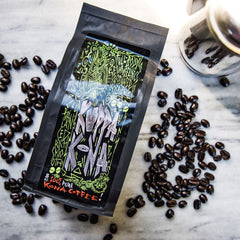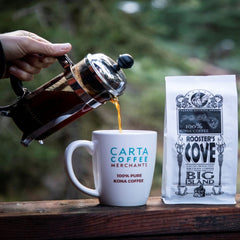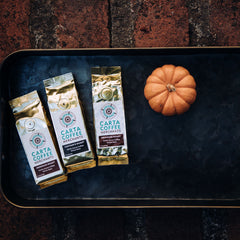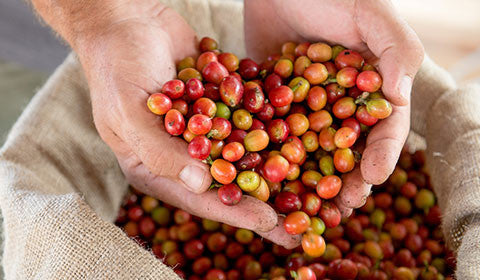Posted on

If you’re new to the coffee scene, you might be surprised to learn that “coffee” and “espresso” are two different things. The only similarity they share is that they both come from the same kind of coffee bean and the same kind of plant – Robusta or Arabica. There is no such thing as an “espresso bean”.
We’re going to take a look at the similarity (singular) and differences (plural) between coffee and espresso.
Roast
The roast is the only similarity that coffee and espresso shares. Technically, “espresso roast” beans can be used in both coffee and espresso. The roast only serves to change the flavor and create the desired characteristics of the drink.
Beans are very important, however. You’ll want to start off with high quality beans. No matter how good your brewing process is, you’ll wind up with a poor tasting beverage if you use grocery-store tier beans.
It’s up to your personal preference as to what makes a good espresso bean. Some people prefer a dark roasted bean that has a bold flavor and full-body, while others prefer a lighter flavor/body. The only way to tell is to experiment. Buy small sizes of different types of roasts, brew a cup, and then compare what you think tastes better.
The Grind
The grind is where coffee and espresso shake hands and amicably go their separate ways. A fine grind (using a burr grinder) is preferred for espresso while a medium grind is preferred for your run of the mill pour-over or drip coffee. The consistency of the espresso grind is almost as fine as powdered sugar.
The more finely you grind the beans, the slower the espresso comes out. The opposite holds true for coffee. The more coarsely ground the beans are, the longer the water stays in contact with the grind. This is why it takes just a few seconds for a shot of espresso to brew versus a few minutes for a pot (or cup) of coffee.
A general rule of thumb to keep in mind is that the shorter the time of contact between water and coffee grind, the finer the grind must be.
The Brew
Espresso is usually made with a specialized machine. This machine forces hot water through finely ground coffee under high pressure. It results in a highly concentrated liquid. It can have a caramelly sweetness to it and sometimes will have a layer of crema (natural foam) on top. It’s been said that the water should be in contact with the coffee grinds for only 25 seconds.
The brewing time for espresso is a lot shorter, thanks in part to the machine whose job it is to force 1.5 ounces of boiling water through tightly packed grinds. The machine generates up to 15 atmospheres of pressure to physically force the water through the coffee.
The mechanics behind making a good cup of espresso are pretty simple and straight-forward. However, it is easier said than done. Brewing a good cup of espresso requires timing, deft hands and most importantly: practice.
When coffee is brewed, it can be via the drip or pour-over method. In both cases the machine will pour water over coarsely ground coffee beans and the water will stay in contact with the grind for much longer than it would with espresso. This process is much slower than the espresso process and the hot water is physical contact with the ground up coffee for a longer period of time.
Believe it or not, a 12oz cup of coffee has more caffeine in it than a 2oz double espresso shot. The cup of coffee averages 120mg of caffeine while the shot of espresso averages around 80mg of caffeine. Of course, all things being equal, espresso has a higher caffeine content rating, however, due to the way it is consumed, the dosage of caffeine that you receive is much smaller than a 12oz cup of coffee.
The Crema
When you make an espresso shot with an espresso machine, you’ll wind up with a small layer of foam on the top. Resembling the head of a freshly poured beer, this layer of foam is called the “crema”.
You can learn a few things about your espresso drink from just looking at the crema.
The first thing you can tell is whether or not the beans used to make the espresso drink were fresh. If the coffee beans were freshly roasted, it will have a nice sized crema. This is due to the science involved in created espresso – water that is under high pressure is able to dissolve more carbon dioxide which is produced in the roasting process. When the water hits the cup, the gas (carbon dioxide) floats to the top thereby creating the crema.
Small crema? A sign that your coffee beans are not that fresh, as most of the carbon dioxide has escaped due to time elapsing since they were first roasted.
You can also tell the strength of your cup of espresso by looking at the color. If you have a dark crema, it’s a sign that the espresso is very strong.
The Bottom Line
Coffee and espresso couldn’t be more different. Espresso can be considered more versatile as it’s used as the base for many drinks such as an Americano or White Chocolate Mocha. Coffee is preferred by people who are looking for a quick fix, especially those who are in a rush to get to work in the morning and would rather brew a quick pot than deal with the multiple steps it takes to make a good cup of espresso.
The only similarity between the two are the beans. If you use poor-quality beans you’re going to get a poor-quality drink. Fortunately, it’s easy to avoid poor quality beans - stop buying them at the grocery store. By the time the beans hit the grocery store shelves, enough time has passed that they are borderline stale.
Instead look for bespoke coffee bean merchants who care more about how their coffee tastes than how many bags they can sell.
